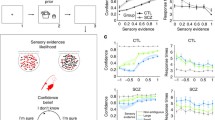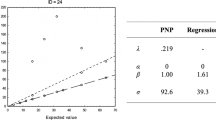Abstract
Probabilistic inference is assumed to be aberrant in deluded patients. Here, we present two novel tasks, designed to measure these computational parameters. Our shape precision task measures the precision of visual short term memory and perceived precision (confidence judgement). This provides a direct assessment of the prediction error. Our probability task is a modification of the “beads in a jar” task. Our version asks for probability estimates after each bead drawn. We derived the mathematical optimal solution and compared it to the estimates of the participants. 15 healthy subjects and 15 patients diagnosed with psychosis played the tasks. Results: patients think their memory is better than it actually is. Further, their probability judgment is worse than that of healthy controls. There was a strong correlation between perceived precision and the probability judgements. Thus, both tasks may measure the same underlying statistical inference mechanism – which is disturbed in deluded patients.
Access this chapter
Tax calculation will be finalised at checkout
Purchases are for personal use only
Preview
Unable to display preview. Download preview PDF.
Similar content being viewed by others
References
Adams, W.J., Graf, E.W., Ernst, M.O.: Experience can change the ‘light-from-above’ prior. Nature Neurosci 7(10), 1057–1058 (2004)
Ernst, M.O., Banks, M.S.: Humans integrate visual and haptic information in a statistically optimal fashion. Nature 415, 429–433 (2002)
Kersten, D., Mamassian, P., Yuille, A.: Object perception as Bayesian inference. Annual Rev. Psychol. 55, 271–304 (2004)
Sinha, P., Poggio, T.: Role of learning in three-dimensional form perception. Nature 384, 460–463 (1996)
Fletcher, P.C., Frith, C.D.: Perceiving is believing: a Bayesian approach to explaining the positive symptoms of schizophrenia. Nature Rev. Neurosci. 10(1), 48–58 (2009)
Pellicano, E., Burr, D.: When the world becomes ‘too real’: a Bayesian explanation of autistic perception. Trends Cogn. Sci. 16(10), 504–510 (2012)
Van de Cruys, S., Evers, K., van der Hallen, R., van Eylen, L., Boets, B., de Wit, L., Wagemans, J.: Precise minds in uncertain worlds: predictive coding in autism. Psychol. Review 121(4), 649–675 (2014)
Rescorla, R.A., Wagner, A.R.: A theory of Pavlovian conditioning: variations in the effectiveness of reinforcement and nonreinforcement. In: Black, A.H., Prokasy, W.F. (eds.) Classical Conditioning II: Current Theory and Research. Appleton-Centiry-Crofts, New York (1972)
Sutton, R.S., Barto, A.G.: Time-derivative models of Pavlovian reinforcement. In: Gabriel, M., Moore, J. (eds.) Learning and Computational Neuroscience: Foundations of Adaptive Networks, pp. 497–537. MIT Press, Cambridge (1990)
Atkins, J.E., Fiser, J., Jacobs, R.A.: Experience-dependent visual cue integration based on consistencies between visual and haptic percepts. Vision Res. 41, 449–461 (2001)
Fiser, J., Berkes, P., Orban, G., Lengyel, M.: Statistically optimal perception and learning: from behavior to neural representations. Trends Cogn. Sci. 14(3), 119–30 (2010)
Payzan-LeNestour, E., Bossaerts, P.: Risk, unexpected uncertainty, and estimation uncertainty: Bayesian learning in unstable settings. PLoS Computational Biology 7, 1–14 (2011)
Yu, A.J., Dayan, P.: Expected and unexpected uncertainty: ACh and NE in the neocortex. In: Becker, S.T.S., Obermayer, K. (eds.) Advances in Neural Information Processing Systems 15. MIT Press, Cambridge (2003)
Yu, A.J., Dayan, P.: Uncertainty, neuromodulation and attention. Neuron 46, 681–692 (2005)
Bland, A.R., Schaefer, A.: Different varieties of uncertainty in human decision making. Front Neurosci. 6, 85 (2012)
Huq, S.F., Garety, P.A., Hemsley, D.R.: Probabilistic judgments in deluded and non-deluded subjects. Q. J. Exp. Psychol. A 40(4), 801–12 (1988)
McKay, R., Langdon, R., Coltheart, M.: Need for closure, jum** to conclusions, and decisiveness in delusion-prone individuals. J. Nerv. Ment. Diseas. 194(6), 422–426 (2006)
Moritz, S., Woodward, T.S., Lambert, M.: Under what circumstances do patients with schizophrenia jump to conclusions? A liberal acceptance account. Br. J. Clin. Psychol. 46, 127–137 (2007)
Moutoussis, M., Bentall, R.P., El-Dredy, W., Dayan, P.: Bayesian modelling of Jum**-to-conclusion bias in delusional patients. Cogn. Neuropsychiatry 16, 422–447 (2011)
Rodier, M., Prévost, M., Renoult, L., Lionnet, C., Kwann, Y., Dionne-Dostie, E., Chapleu, I., Debruille, J.B.: Healthy people with delusional ideation change their minds with conviction. Psychiat. Res. 189, 433–439 (2011)
Peters, E.R., Moritz, S., Schwannauer, M., Wiseman, Z., Greenwood, K., Scott, J., Beck, A.T., Donaldson, C., Hagen, R., Ross, K., Veckenstedt, R., Ison, R., Williams, S., Kuipers, E., Garety, P.A.: Cognitive biases questionnaire for psychosis. Schizophr Bull 40(2), 300–313 (2014)
Roets, A., Van Hiel, A.: Item selection and validation of a brief, 15-item version of the need for closure scale. Personal Individ. Diff. 50(1), 90–94 (2011)
Pfuhl, G., Tjelmeland, H., Molden, S., Biegler, R.: Optimal cache search depends on precision of spatial memory and pilfering, but what if that knowledge is not perfect? Anim. Beh. 78(4), 819–828 (2009). doi:10.1016/j.anbehav.2009.06.014
Author information
Authors and Affiliations
Corresponding author
Editor information
Editors and Affiliations
Rights and permissions
Copyright information
© 2015 Springer International Publishing Switzerland
About this paper
Cite this paper
Pfuhl, G., Sandvik, K., Biegler, R., Tjelmeland, H. (2015). Identifying the Computational Parameters Gone Awry in Psychosis. In: Guo, Y., Friston, K., Aldo, F., Hill, S., Peng, H. (eds) Brain Informatics and Health. BIH 2015. Lecture Notes in Computer Science(), vol 9250. Springer, Cham. https://doi.org/10.1007/978-3-319-23344-4_3
Download citation
DOI: https://doi.org/10.1007/978-3-319-23344-4_3
Published:
Publisher Name: Springer, Cham
Print ISBN: 978-3-319-23343-7
Online ISBN: 978-3-319-23344-4
eBook Packages: Computer ScienceComputer Science (R0)




